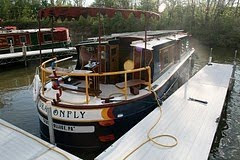The current Erie Canal (officially, the New York State Barge Canal) is not quite so antique--this reboot of the original 1825 canal system was completed in 1918 and some locks modernized after that. But there's still some original 1918 equipment in some locks, notably the electrical systems that operate the lock gates and sluices.
Also dating to 1918: a kind of stationary winch, resembling an oversized hand-grenade. It's used to haul barges OUT of the lock after a tugboat pushes them in.
(If that sounds confusing, here's how it works. With the barge filling the lock, there's no room for the tug. So the barge rides up (or down) alone. Then the locktender winches the barge out so the tug can also lock through.)
 |
| Every lock has a stylish little iron arch over it. That's to carry the wiring across the lock. |
"Yeah, the original since 1918 and they still work great," said Tim, a husky guy with grizzled hair.
"All DC! Much more reliable than AC.
Edison had it right! Ha! Him and Tesla. These new locks are no good, they break
down all the time."
Tim Had Time for a Story
Tim leaned in to the railing, settling in. "Lemme tell you a story. You know Lock 19? "
Yes, we locked through there yesterday.
"Well, I used to work there. You know how there’s a railroad bridge right before the lock, and then right after the bridge, a super
narrow channel just before the lock?"
Yes. The locktender warned us to stay well back while he dumped the water from the lock . Told us we could get really banged around on the cement walls if we were too close.
 |
| This is what a sportfisher looks like when it's not up on plane. |
Cruisin' for a Bruisin'
Big Tim says, "Yeah. So I had a couple kayakers in there, taking them
down. I start to open the gates, to let them out, and I look down the channel, and this big sportfisher (a very large open-water-type boat) is coming up at 35
mph.
"So I rush to get on the radio and I tell him, 'Slow down! Slow down!'
"The boat is up on plane. The guy drops his speed
and the bow of the boat drops and sets up a four-foot wave! (We've seen this, BTW, in Florida. A sportfisher rode its own wave to get over a shallow spot in a channel.)
"The wave hits that narrow channel before the lock doors and gets even bigger. Then it hits the doors, and they swing . . . in and out and in and out.
"The kayakers are screaming for their lives. I’m telling them, "Hold on to the lines,
you’ll be fine. I’m more worried about my lock doors.
"Those doors are meant to open at half a mile per hour, and here they're swinging back and forth at 40 mph. Parts flying everywhere.
"So the guy in the boat gets on the radio and says, 'Oh, did I do
that?'
"Yeah, you did that. (You idiot!)
"So the sportfisher says, 'When can you lock me through?'
When Hell Freezes Over?
Big Tim says, “You got any beer on that boat? Yeah?
"Well, you tie up there and start drinking because it’s gonna take a while to fix this
one.”
(No risk of this kind of incident while piloting a slow boat, right?
And Tim liked our solar panels. DC. Like Edison and Tesla.)






No comments:
Post a Comment